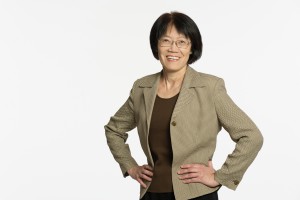
Li Jian, E. Rhodes and Leona B. Carpenter Curator of East Asian Art, has been at the VMFA for since 2008. Prior to joining the Virginia Museum, she directed the reinstallation of the Asian Wing at the Dayton Art Institute. Li Jian has also published two catalogues to accompany exhibitions, Eternal China: Art from the First Dynasties (1998) and The Glory of the Silk Road: Art from Ancient China (2003). She studied in Beijing and received her Bachelor’s degree in English and management and then went on to the University of Minnesota where she received her Masters in Art History. Li Jian completed the installation of VMFA’s East Asian galleries in 2012 and has broadened the collection of Chinese, Japanese, and Korean works. Her most recent exhibition and catalogue was Forbidden City: Imperial Treasures from the Palace Museum, Beijing (2014).
Interview with Curator, Li Jian, Transcript
GB: I’m Grace Bland, and I am a MLiT student here [at the VMFA]. Today I’m with Li Jian, the East Asian curator. Our first question is: How long would it have taken to make a scroll like this?
LJ: This scroll was made in the 14th century in Japan during the Kamakura period. A painting like this, would have taken at least two months to paint, and then to mount this hanging scroll, it would have taken about the same amount of time.
GB: Can you explain some of the gold leaf process and what it is called?
LJ: In this technique, gold foil is applied. Gold foil is very thin gold paper that is cut into tiny pieces. If you look closely at the deity’s (Monju’s) jewelry in the painting, you can see the golden color. You can also see the golden foil on the diety’s costume. Gold leaf was applied on important and precious objects, including lacqureware, paintings, and sculptures.
GB: When and where does this process (using golden foil) originate?
LJ: Most scholars believed that it was originally made in China during the Tang period in the 7th and 8th centuries. Because there was a great amount of exchange between China and Japan during this period, this technique [kirikane in Japanese], was introduced to Japan, and consequently, used for many years to come.
GB: What would this scroll have been used for and who would have owned it?
LJ: That’s a good question! We all know the religious painting originally came from the mural in the temple, very much like oil painting appeared in a Christian church. So you see murals in the temple, high above the wall, and later people felt they needed portable paintings with an image of a deity. The hanging scrolls like this were made so that Buddhists and other believers, could worship the deities privately when they travel, or at home.
GB: Why did you choose this piece for the VMFA and this gallery?
LJ: First, we acquired this painting and most of our Buddhist hanging scrolls, in the sixties. During that time, the museum contracted a curator, who retired from the Metropolitan Museum of Art to acquire artworks for the museum. This curator, Alan Priest (1898-1969), who lived in Kyoto, Japan in the 1960s, helped the museum acquire nearly eighty paintings and calligraphy.
Explore More:
Monju Scroll: Scroll Through the Past